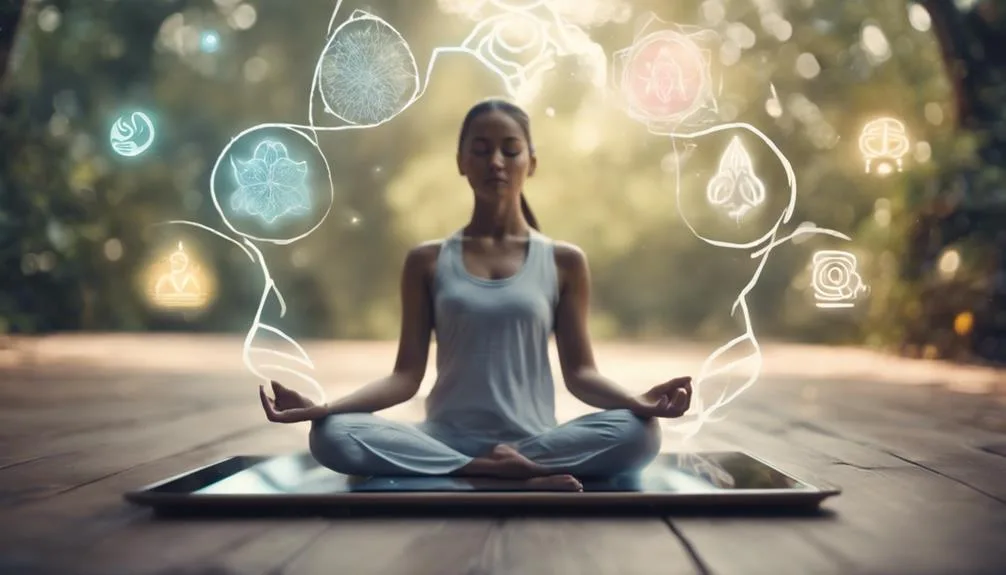The practice of sitting meditation, with its roots deeply embedded in ancient traditions, presents a compelling exploration into the human mind and spirit. As we consider the variety of postures available, from the disciplined Lotus to the accessible Chair position, it becomes clear that this practice is as much about physical alignment as it is about mental and spiritual harmony.
The question then arises: how do these positions, each with their unique physical demands and benefits, influence the depth and quality of meditation? This inquiry not only invites a closer look at the physical aspect of meditation but also beckons a deeper understanding of its profound effects on our well-being, suggesting that the secret to unlocking the full potential of sitting meditation lies in a nuanced appreciation of posture and its impact on the meditative experience.
Key Takeaways
- Experiment with various sitting positions like Lotus, Seiza, and Burmese for optimal comfort and focus in meditation.
- Utilizing cushions can enhance comfort in positions like Full Lotus or Seiza, facilitating longer meditation sessions.
- Chair meditation offers a beginner-friendly alternative, emphasizing proper posture for alertness and engagement.
- Each posture should ensure a straight back and relaxed muscles, pivotal for maintaining focus and achieving deeper meditation states.
Essential Sitting Postures
Adopting the correct sitting posture is a foundational element in the practice of meditation, serving both to enhance the meditative experience and to ensure physical comfort during the session. Exploring alignment is crucial as it directly influences one's ability to remain focused and undisturbed for extended periods. Proper alignment involves the harmonious positioning of the head, neck, and spine, creating a natural but erect posture that promotes ease and alertness.
Cushion adjustments play a significant role in this aspect; they support maintaining the natural curvature of the spine and facilitate a comfortable seating position. A well-adjusted cushion can alleviate pressure on the legs and hips, making the meditative journey more accessible and profound. Mindfully adjusting one's posture and cushion can lead to a deeper, more fulfilling meditation practice.
Choosing Your Meditation Position
Selecting an appropriate meditation position is a pivotal step in establishing a practice that is both comfortable and conducive to mindfulness. When embarking on this journey, exploring variations in sitting postures can significantly enhance your experience.
The key lies in finding comfort and stability within your chosen position, whether it be the traditional lotus poses, the supportive chair position, the grounded seiza pose, or the accessible Burmese position. Each posture offers unique benefits, but the ultimate goal is to facilitate a state of deep focus and relaxation.
Benefits of Mindful Communication

Exploring the realm of mindful communication opens up new avenues for enhancing our interactions and connections with others. This practice fosters an environment where empathy and understanding flourish, leading to deeper, more meaningful relationships. By embracing the principles of mindful communication, individuals can experience a transformative shift in how they connect with those around them.
Key benefits include:
- Improved relationships through increased patience and openness.
- Empathetic listening that fosters a deeper understanding of others' perspectives.
- Enhanced ability to express oneself clearly and thoughtfully.
- Reduced misunderstandings and conflicts, promoting a harmonious environment.
Adopting mindful communication practices enriches not only our personal interactions but also contributes to a more compassionate and connected world.
Insights From Buddhism
Buddhism, with its rich heritage and profound teachings, provides invaluable insights into navigating the complexities of human suffering and finding paths toward liberation and enlightenment. Central to Buddhist philosophy is the understanding that life is inherently marked by suffering, but through meditation techniques, individuals can cultivate mindfulness, compassion, and wisdom to transcend this suffering.
These practices encourage a deep exploration of the mind and its patterns, offering a path to inner peace and understanding. By integrating sitting meditation into daily life, adherents can develop a heightened awareness of the present moment, fostering a profound connection with themselves and the world around them.
This mindful approach, rooted in centuries of Buddhist wisdom, guides individuals on a transformative journey towards a more enlightened, compassionate existence.
Exploring Mind Trainer Resources

Why not delve into the comprehensive Mind Trainer resources designed to enhance your meditation practice and deepen your understanding of mindfulness? These resources are meticulously curated to guide you through various meditation techniques, ensuring a profound journey into mindfulness.
Here's what you can explore:
- Guided Meditation Sessions: Step-by-step instructions to ease you into meditation, making it accessible for beginners and enriching for seasoned practitioners.
- Articles on Mindfulness: Deep dives into the philosophy and practical implementation of mindfulness in daily life.
- Instructional Videos: Visual guides demonstrating meditation techniques, postures, and breath work.
- Interactive Q&A Sessions: Opportunities to ask questions and gain insights from experienced meditation instructors.
These Mind Trainer resources are designed with empathy and understanding, aiming to support your meditation journey every step of the way.
Frequently Asked Questions
How Does One Manage Physical Discomfort or Pain During Longer Meditation Sessions?
To manage physical discomfort during extended meditation sessions, mindfulness distraction techniques can be applied, focusing attention away from pain. Additionally, careful cushion selection can enhance comfort, ensuring a posture that supports prolonged periods of meditation effectively.
Can Sitting Meditation Improve Posture and if So, How Does It Do This Over Time?
Sitting meditation can be a game changer for posture, fostering mindfulness benefits that enhance emotional stability. Over time, it encourages a straighter spine and relaxed shoulders, leading to improved physical and mental well-being.
Are There Specific Breathing Techniques That Should Be Paired With Different Sitting Meditation Postures for Enhanced Benefits?
Pairing specific breathing techniques, such as breath awareness and Pranayama basics, with meditation postures can enhance benefits. These practices foster deeper relaxation and mindfulness, optimizing the meditative experience for practitioners seeking improved well-being and mental clarity.
How Can One Maintain a Consistent Meditation Practice Amidst a Busy Schedule or Frequent Interruptions?
Maintaining a regular meditation practice amid a bustling schedule can be challenging. Embrace mindful multitasking and digital detoxing to carve out serene moments, fostering a consistent practice that aligns with your lifestyle and responsibilities.
What Modifications Can Be Made for Individuals With Mobility Issues or Injuries to Safely Practice Sitting Meditation?
For individuals with mobility issues or injuries, chair modifications and prop adjustments can enhance the safety and comfort of sitting meditation practices. Consider using supportive cushions and ensuring a posture that aligns with bodily needs.
Conclusion
In conclusion, the practice of sitting meditation serves as a key that unlocks the door to enhanced mental and physical well-being.
By embracing the variety of postures detailed, individuals can tailor their meditation experience to suit personal comfort and needs, thereby fostering a deeper connection to the practice.
Like trees deeply rooted in the earth, steadfast in various climates, so too can practitioners become in their journey towards mindfulness and serenity, guided by the invaluable resources offered by Mindworks.

